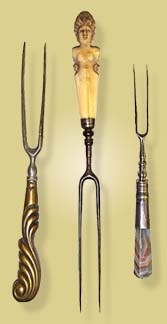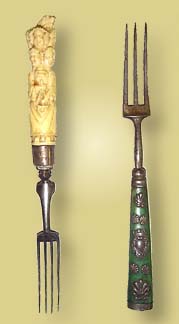

 FORKS
FORKS
Kitchen forks trace their origins back to the time of the Greeks. These forks were fairly large with two tines that aided in the carving and serving of meat. The tines prevented meat from twisting or moving during carving and allowed food to slide off more easily than it would with a knife.
By the 7th Century CE, royal courts of the Middle East began to use forks at the table for dining. From the 10th through the 13th Centuries, forks were fairly common among the wealthy in Byzantium, and in the 11th Century, a Byzantine wife of a Doge of Venice brought forks to Italy. The Italians, however, were slow to adopt their use. It was not until the 16th Century that forks were widely adopted in Italy.
 In 1533, forks
were brought from Italy to France when Catherine de Medicis married the future
King Henry II. The French, too, were slow to accept forks, because using them
was thought to be an affectation.
In 1533, forks
were brought from Italy to France when Catherine de Medicis married the future
King Henry II. The French, too, were slow to accept forks, because using them
was thought to be an affectation.
|
CAS 0389-1537: detail of Turkish fork handle |
|---|
CAS
0389-1831: 19th C. German (?) fork (left)
CAS 0389-2098: 17th C. German or English fork (center)
CAS 0389-1975: 18th C. English fork (right)
An Englishman named Thomas Coryate brought the first forks to England after seeing them in Italy during his travels in 1608. The English ridiculed forks as being effeminate and unnecessary. "Why should a person need a fork when God had given him hands?" they asked. Slowly, however, forks came to be adopted by the wealthy. They were prized possessions made of expensive materials intended to impress guests. Small, slender-handled forks with two tines were generally used for sweet, sticky foods or for foods such as berries which were likely to stain the fingers. By the mid 1600s, eating with forks was considered fashionable among wealthy British. Forks used solely for dining were luxuries and thus markers of social status and sophistication among nobles.
 Early
table forks were modeled after kitchen forks; two fairly long and widely spaced
tines ensured that meat would not twist while being cut. This
style of fork was soundly designed, but small pieces of food regularly fell
through the tines or slipped off easily. In late 17th Century
France, larger forks with four curved tines were developed. The additional tines
made diners less likely to drop food, and the curved tines served as a scoop
so people did not have to constantly switch to a spoon while eating. By the
early 19th Century, multi-tined forks like those pictured to the left had also
been developed in Germany and England and slowly began to spread to America.
Early
table forks were modeled after kitchen forks; two fairly long and widely spaced
tines ensured that meat would not twist while being cut. This
style of fork was soundly designed, but small pieces of food regularly fell
through the tines or slipped off easily. In late 17th Century
France, larger forks with four curved tines were developed. The additional tines
made diners less likely to drop food, and the curved tines served as a scoop
so people did not have to constantly switch to a spoon while eating. By the
early 19th Century, multi-tined forks like those pictured to the left had also
been developed in Germany and England and slowly began to spread to America.
CAS 0389-1614:
18th C. Dutch or German fork (left)
CAS 0389-1971: 19th C. German fork (right)